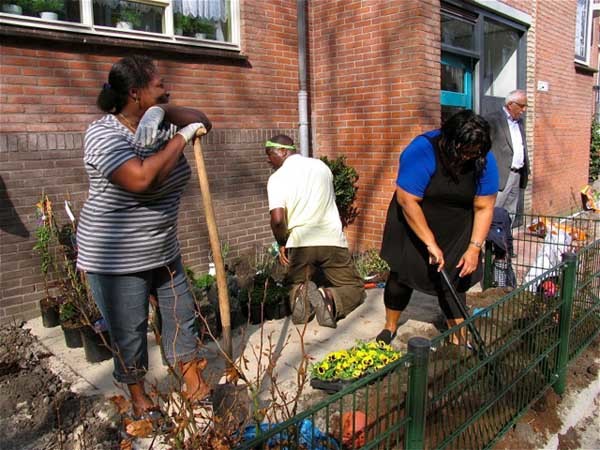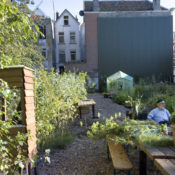Author: wolbert van dijk
Residents give their street a new face
In the period of the ’80 the urban structure of the neighborhood has been restructured. The result is more space, more sunlight in the streets and wider sidewalks, but also more gray stones. After thirty years the residents of the Bloemkwekersstreet took action to improve their street with the initiative and construction of gardens, named Frontgardens XXL. The result is impressive.
It started with a dirty chat between two neighbors who know each other from The Tussentuin in Rotterdam. One neighbor had just tidying up the sidewalk, because there was human excrementon on it. He was thinking of a solution and wanted to plant bushes with thorns. The other, a professional landscape architect and garden designer, had another idea: a garden along the entire length of the wide sidewalk in their street. Bushes with thorns are fine, but beauty is what people really need. He already made a plan, inspired by the atmospheric of another street in this city. So the initiative for making Frontgardens was born. One neighbor writes a story and asks the other neighbors to support and get signatures. Also two collages of the street in the ‘future’ where made. These collages helped by dissolve all existing doubts of whether it could be something with the street. The residents send their proposal to the local government to get a financial support. They responded positive and even the people of the Department of Urban Development had tears in the eyes by reading this proposal. There was goodwill and there was money.
The design of the gardens was made and the Public Department of the city constructed the framework of the gardens and the fences. The devices of the gardens would be done by the residents themselves. On the first Saturday, all hedges where planted and two gardens where devised, with a lot of attention from neighbors and food passengers. On the second Saturday, the other gardens where decorated. Two elderly neighbors didn’t want a garden with plants, but a tiled garden. With the help of other neighbors one tiled garden transformed in a garden with plants in pots. They started with tree big pots and a week later there where six. This was an inspiration for the other tiled garden
On the third Saturday some finishing touches had to be made. Nature had to take over and time was necessary to let the plants get grown. Residents and the local government where surprised to see the results and the metamorphosis of their street. However, some people where critical about it and said; “How beautiful, but……..will the people continuing to maintain their gardens? And will ‘they’ (the youth) not ruining it?” Time will prove, but the first experience is that of admiration and respect for the gardens. Residents are taking care of their own gardens and there is a sense of responsibility for the street. For the first time in thirty years there are daily chats between people how are working in the gardens and people how are walking on the side walk.
The Tussentuin (the in-between garden) brings people together
A housing demolition project in Rotterdam Netherlands has turned into an opportunity for a community to grow together. The removal of the houses on Gaffelstraat 70-88 created a temporary open space between existing streets and houses and has been reclaimed by local residents to create a vibrant community garden dubbed De Tussentuin, the “in between” garden.
The design of this temporary garden tells the story of the demolishing houses and of the colorful histories of the people who lived there. The former house lots are now used as a flower or a kitchen garden. The result is a patchwork of different colors, images and atmospheres with a strong relationship between each other. The neighborhood uses the garden just for watching, for hanging around, gardening or to listen to music. There is a long community dining table and a tent for bands to play afternoon concerts with acoustic music. The garden has become an important part of the neighborhood and brought the residents closer to each other.
The structure of the garden is simple and consists grassy paths, one wide path in the middle that connects all the plots and is surrounded by a hedgerow. Within this structure, each resident has a private plot and is responsible for that plot. The hedgerow consist a range of native trees and shrubs, such as Amelanchier lamarckii, Crataegus laevigata ‘Paul’s Secret, Populus alba and Populus tremula. This variety of plants creates an exuberant bloom and has nice autumn hues. The collective garden is separated from the public space by a fence overgrown with Wisteria sinensis ‘Alba’ and Clematis armandii.
Aside from the fun that all the gardeners, musicians and visitors have, the Tussentuin has also a social and physical spin off for the neighborhood. People have seen that projects like these can be realized with the energy of residents – by claiming public space and making their own environment livable. At the beginning of 2013 they will start with the construction of the new houses. In the meantime, the gardeners are searching for another location. They want another place close to the street or square so that they can create a beautiful and attractive place for himself and for everyone who wants to enjoy their.
Are you inspired by this project? Or, do you have a similar story to share? Please leave a comment below… Thanks!









